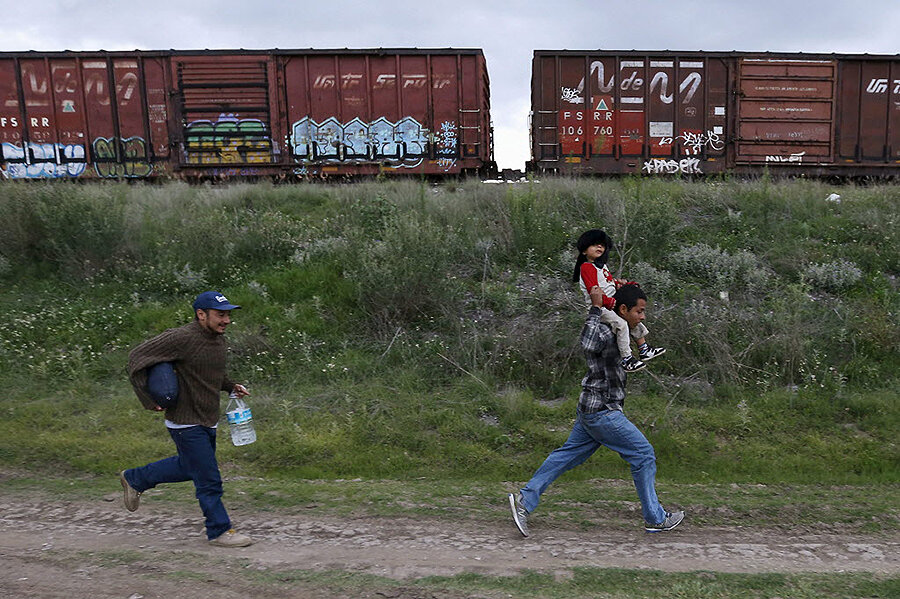The face of migration via Mexico
| Mexico City
Individuals migrating from Central America and Mexico to the United States without legal documentation are nothing new, but in recent years the context around these journeys north has changed dramatically.
Q: Who is trying to make the journey to the US these days?
Mexican net migration has been falling for the past 15 years, and in 2015 hit the lowest levels in more than five decades. That’s due, in part, to slower population growth and an improved Mexican economy. But hundreds of thousands of undocumented immigrants and asylum-seekers still try to make their way to the US southern border in search of safety or opportunity each year.
Migrants and refugees from Central America – primarily Guatemala, El Salvador, and Honduras – account for the bulk of non-Mexicans arrested at the border. Some important sub-groups have emerged since 2014, including women and children traveling alone or lesbian, gay, bisexual, or transgender migrants fleeing threats or persecution at home.
But migrants are traveling from much further afield as well. Haitians, Cubans, and migrants from parts of Africa and Asia have been making their way across South, Central, and North America in recent years in order to enter the US at its southern border.
Q: What role is Mexico playing in halting migration north?
Despite all the attention on the US-Mexico border, the gateway to the United States is no longer necessarily in Texas or California. The “border” could now be considered over a thousand miles south, where Mexico meets Guatemala. That was the realization, at least, in 2014, when tens of thousands of unaccompanied minors from across Central America were arriving in the United States via Mexico. At the urging of the US, Mexico launched Plan Frontera Sur, a program that aims to formalize Mexico’s southern border entry-and-exit practices, and to decrease human rights violations suffered by migrants there.
As a result, detentions at the southern border jumped, and Mexico doubled the number of deportations along its southern border during the program’s first full year.
Plan Frontera Sur changed the way migrants move through Mexico, and human rights groups say it’s made the journey riskier. Men, women, and children en route to the US are being pushed into the shadows in an effort to evade officials, whom migrants said were responsible for 41 percent of the crimes they'd experienced en route, according to a report from a migrant-support network.
Fewer migrants are traveling north on trains, which often led to life-altering injuries or death, but ran along a network of shelters that could feed or house migrants, and help connect them to medical or legal support. It’s also opened channels for criminal gangs to get more involved in moving migrants across the country, often charging a hefty sum and not providing any real guarantee of safety.
Q: Are there destinations for Central American migrants other than the US?
As the journey to the United States becomes riskier – and President Trump pledges to crack down on immigrants residing in the US without proper documentation – many migrants are halting their journeys early, or heading in new directions in search of safety or opportunity. Mexico has seen a sharp uptick in asylum applications, expecting numbers to reach 20,000 this year. That compares with 3,400 asylum requests in 2015. Nearby Belize and Costa Rica are also seeing more arrivals from the Northern Triangle, made up of Guatemala, El Salvador, and Honduras.
And leaving home doesn’t always mean a lengthy journey: An estimated 714,000 people from the Northern Triangle are internally displaced, according to the Humanitarian Practice Network. Often people move to another town or city in the face of threats or economic hardship, before considering an arduous journey north.
Q: What happened this summer, when 10 migrants died in a tractor-trailer incident?
In July, a tractor-trailer filled with more than 100 people was discovered in a San Antonio, Texas, parking lot. The trailer was stifling hot with little access to fresh air and a malfunctioning refrigeration system. And despite passengers – undocumented migrants mostly from Central America and Mexico – banging on the walls of the trailer for help, eight people were already dead by the time the doors were opened. Another two people later died in the hospital.
The driver, a US citizen who says he wasn’t aware that he was transporting people, is being tried on human smuggling charges. The tragedy underscores the sophistication of human trafficking across the border today, as well as the desperation that fuels many migrants to reach a country of perceived safety at any cost.
The increased presence of US officials at the border, and more checkpoints moving inside the US, north of high-traffic crossing points, means migrants are taking increasingly big risks. That can mean crossing into dangerous terrain and perishing in desert heat – or cold – or paying criminal groups to help move them across the border. Trafficking across the border has become a lucrative business: The cost of transporting a migrant from Central America through Mexico has more than doubled since October 2016, going from roughly $3,500 to $8,000, according to Stratfor, a security analysis and consulting company.
Q: Why are people migrating to the US in the first place?
It depends. For many in the Northern Triangle, leaving home is a life or death decision. El Salvador and Honduras have two of the highest murder rates in the world for countries not officially at war. And a recent report by the Organization of American States found that hunger due to a prolonged drought that began in 2014 is becoming an increasingly central reason for Central Americans to flee.
But there are political reasons, too. An influx of Cuban migrants last year, for example, were racing against the clock to arrive in the US before rumored – and eventually factual – changes to the wet-foot dry-foot policy, which allowed Cubans who reached the US to stay and gain legal residency.






